新概念第一册第43、44课教学提纲
- 格式:ppt
- 大小:471.50 KB
- 文档页数:35
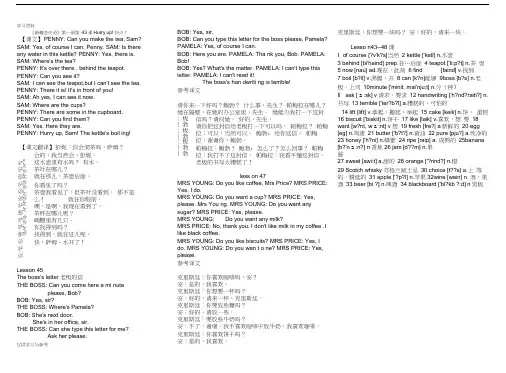
BOB: Yes, sir.BOB: Can you type this letter for the boss please, Pamela? PAMELA: Yes, of course I can.BOB: Here you are. PAMELA: Tha nk you, Bob. PAMELA: Bob!BOB: Yes? What's the matter. PAMELA: I can't type this letter. PAMELA: I can't read it!The boss's han dwriti ng is terrible!参考译文请你来一下好吗?鲍勃? 什么事,先生? 帕梅拉在哪儿? 她在隔壁,在她的办公室里,先生。
她能为我打一下这封信吗?请问她。
好的,先生。
请你把这封信给老板打一下可以吗, 帕梅拉? 帕梅拉:可以,当然可以。
鲍勃:给你这信。
帕梅拉:谢谢你,鲍勃。
帕梅拉:鲍勃! 鲍勃:怎么了?怎么回事? 帕梅拉:我打不了这封信。
帕梅拉:我看不懂这封信,老板的书写太糟糕了! less on 47MRS YOUNG: Do you like coffee, Mrs Price? MRS PRICE: Yes, I do.MRS YOUNG: Do you want a cup? MRS PRICE: Yes, please. Mrs You ng. MRS YOUNG: Do you want any sugar? MRS PRICE: Yes, please. MRS YOUNG: Do you want any milk?MRS PRICE: No, thank you. I don't like milk in my coffee .I like black coffee.MRS YOUNG: Do you like biscuits? MRS PRICE: Yes, I do. MRS YOUNG: Do you wan t o ne? MRS PRICE: Yes, please. 参考译文克里斯廷:你喜欢咖啡吗,安? 安:是的,我喜欢。
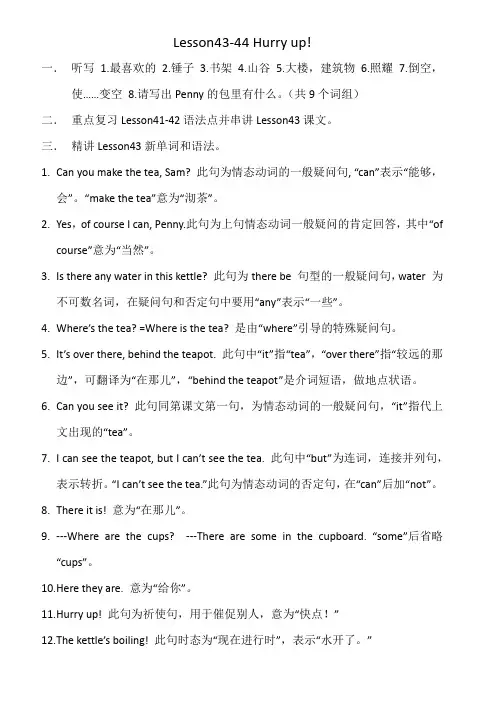
Lesson43-44 Hurry up!一.听写1.最喜欢的2.锤子3.书架4.山谷5.大楼,建筑物6.照耀7.倒空,使……变空8.请写出Penny的包里有什么。
(共9个词组)二.重点复习Lesson41-42语法点并串讲Lesson43课文。
三.精讲Lesson43新单词和语法。
1.Can you make the tea, Sam? 此句为情态动词的一般疑问句, “can”表示“能够,会”。
“make the tea”意为“沏茶”。
2.Yes,of course I can, Penny.此句为上句情态动词一般疑问的肯定回答,其中“ofcourse”意为“当然”。
3.Is there any water in this kettle? 此句为there be 句型的一般疑问句,water 为不可数名词,在疑问句和否定句中要用“any”表示“一些”。
4.Where’s the tea? =Where is the tea? 是由“where”引导的特殊疑问句。
5.It’s over there, behind the teapot. 此句中“it”指“tea”,“over there”指“较远的那边”,可翻译为“在那儿”,“behind the teapot”是介词短语,做地点状语。
6.Can you see it? 此句同第课文第一句,为情态动词的一般疑问句,“it”指代上文出现的“tea”。
7.I can see the teapot, but I can’t see the tea. 此句中“but”为连词,连接并列句,表示转折。
“I can’t see the tea.”此句为情态动词的否定句,在“can”后加“not”。
8.There it is! 意为“在那儿”。
9.---Where are the cups? ---There are some in the cupboard. “some”后省略“cups”。
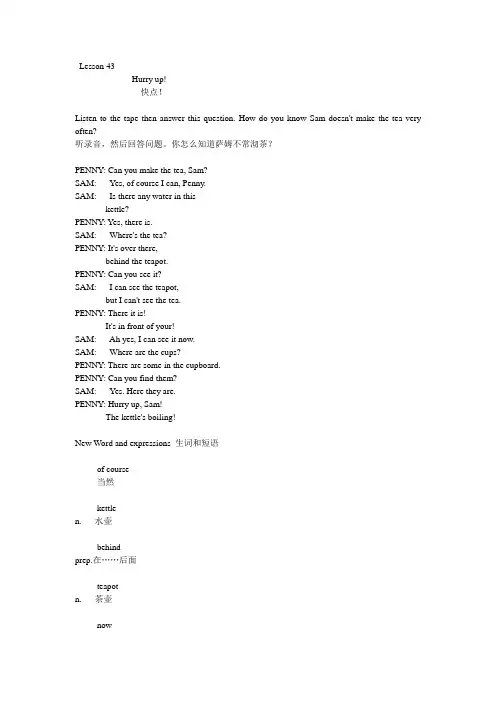
Lesson 43Hurry up!快点!Listen to the tape then answer this question. How do you know Sam doesn't make the tea very often?听录音,然后回答问题。
你怎么知道萨姆不常沏茶?PENNY: Can you make the tea, Sam?SAM: Yes, of course I can, Penny.SAM: Is there any water in thiskettle?PENNY: Yes, there is.SAM: Where's the tea?PENNY: It's over there,behind the teapot.PENNY: Can you see it?SAM: I can see the teapot,but I can't see the tea.PENNY: There it is!It's in front of your!SAM: Ah yes, I can see it now.SAM: Where are the cups?PENNY: There are some in the cupboard.PENNY: Can you find them?SAM: Yes. Here they are.PENNY: Hurry up, Sam!The kettle's boiling!New Word and expressions 生词和短语of course当然kettlen. 水壶behindprep.在……后面teapotn. 茶壶nowadv. 现在,此刻findv. 找到boilv. 沸腾,开参考译文彭妮:你会沏茶吗,萨姆?萨姆:会的,我当然会,彭妮。
萨姆:这水壶里有水吗?彭妮:有水。
萨姆:茶叶在哪儿?彭妮:就在那儿,茶壶后面。
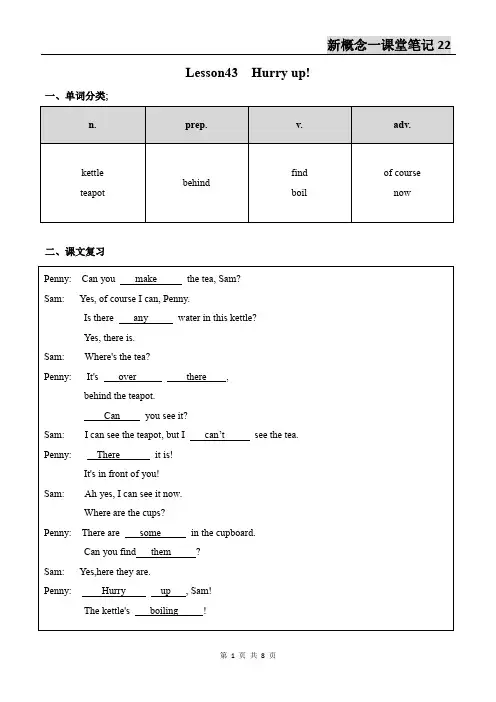

⼀、重要句型或语法 1、情态动词:can 本⾝有⼀定的词义,表⽰语⽓的单词。
但是不能独⽴作谓语,只能和动词原形⼀起构成谓语。
情态动词⽤在⾏为动词前,表⽰说话⼈对这⼀动作或状态的看法或主观设想,如:He can dance./ He can't dance./ Can he dance? Yes, he can. 2、some与any的⽤法:与there be的连⽤ Is there any bread here? Yes, there is. There's some on the table. ⼆、课⽂主要语⾔点 Can you make the tea? make的⽤法可以做回顾拓展,如:make a cake, make coffee, make tea, make the bed等。
Yes, of course I can, Penny. of course相当于第41课中的certainly,表⽰“当然,肯定”。
Is there any water in this kettle? 注意kettle(⽔壶,⽤于烧⽔)和下⽂出现的teapot(茶壶,⽤于泡茶)的区别。
可从合成法⾓度解释teapot,因为它是由tea+pot构成的。
It's over there, behind the teapot. over there表⽰“在那边”,⽤来表⽰离说话者较远的地⽅。
如果较近,可以说“It's right here.”。
behind,可以对⽐复习⼀下in front of和in the front of。
There it is! 表⽰“就在那⼉”,⽤来指出远处的事物。
如果要近指,应该⽤:Here it is! 两者的复数形式分别为:There they are! / Here they are! Can you find them? 注意区分find和look for。
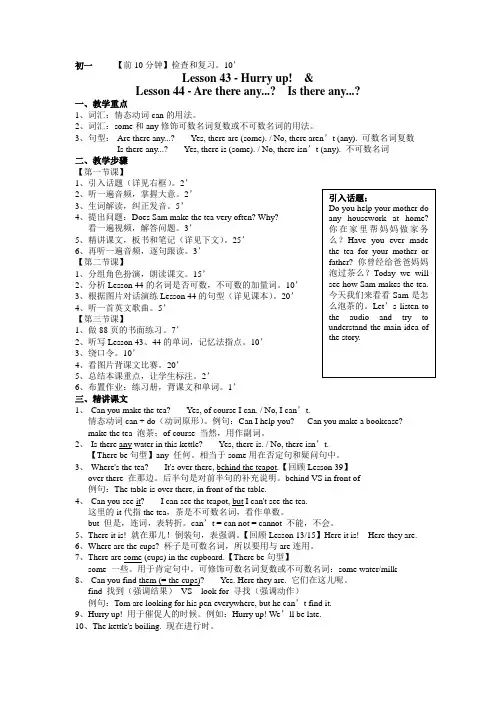
初一【前10分钟】检查和复习。
10’Lesson 43 - Hurry up! &Lesson 44 - Are there any...? Is there any...?一、教学重点1、词汇:情态动词can的用法。
2、词汇:some和any修饰可数名词复数或不可数名词的用法。
3、句型:-Are there any...? -Yes, there are (some). / No, there aren’t (any). 可数名词复数-Is there any...? -Yes, there is (some). / No, there isn’t (any). 不可数名词二、教学步骤【第一节课】1、引入话题(详见右框)。
2’2、听一遍音频,掌握大意。
2’3、生词解读,纠正发音。
5’4、提出问题:Does Sam make the tea very often? Why?看一遍视频,解答问题。
3’5、精讲课文,板书和笔记(详见下文)。
25’6、再听一遍音频,逐句跟读。
3’【第二节课】1、分组角色扮演,朗读课文。
15’2、分析Lesson 44的名词是否可数,不可数的加量词。
10’3、根据图片对话演练Lesson 44的句型(详见课本)。
20’4、听一首英文歌曲。
5’【第三节课】1、做88页的书面练习。
7’2、听写Lesson 43、44的单词,记忆法指点。
10’3、绕口令。
10’4、看图片背课文比赛。
20’5、总结本课重点,让学生标注。
2’6、布置作业:练习册,背课文和单词。
1’三、精讲课文1、-Can you make the tea? -Yes, of course I can. / No, I can’t.情态动词can + do(动词原形)。
例句:Can I help you? Can you make a bookcase?make the tea 泡茶;of course 当然,用作副词。

新概念英语课堂笔记第一册Lesson 43-44behind【用法】prep. 在……后面【词组】behind the door 在门后behind the times 过时;落后于时代【反义】in front of 在……前面【辨析】behind 和at the back ofbehind 在……(外面的)后面;其反义词组为:in front ofat the back of 在……(里面的)后面;其反义词组为:in the front ofnow【用法】adv. 现在,此刻【词组】now and then 时而;偶尔from now on 从现在开始;今后just now 刚才;一会儿以前now that 既然;由于【扩展】nowadays adv. 当今;现在then adv. 那时find【用法】v. 找到,发现(强调找的结果)【词组】find sb. doing …发现某人做……find out 查明,弄清【辨析】find和look forfind强调找的结果,意为“找到”。
例如:I can’t find my bag. 我找不到我的书包。
look for强调找的过程,意为“寻找”。
例如:Lily is looking for her glasses. 莉莉正在找她的眼镜。
Can you make the tea, Sam?【译文】你能沏茶吗,萨姆?【用法】本句是情态动词can的一般疑问句形式。
make the tea 沏茶,动词make可以和许多名词组成固定搭配。
例如:make a fire 生火/ make the bed 铺床Yes, of course I can.【译文】是的,我当然能。
【用法】of course“当然”,这个短语也可以独立使用。
例如:—Could you help me? 你能帮我一下吗?—Of course. 当然了。
其同义表达有:Sure. / Certainly.It's over there.【译文】就在那边。
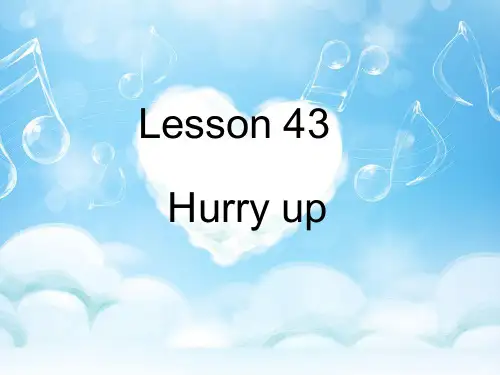
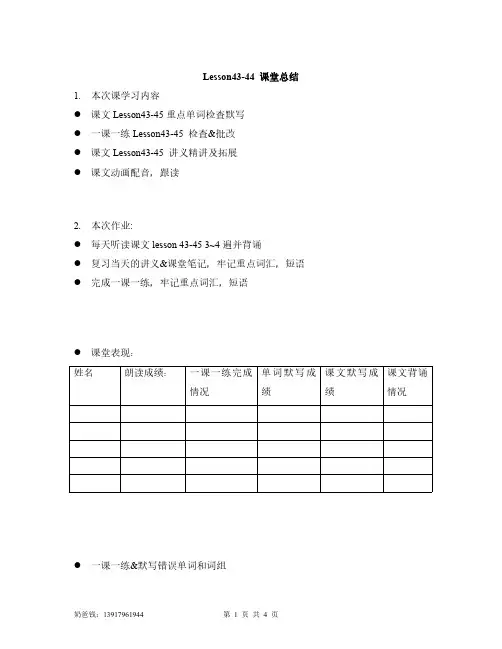
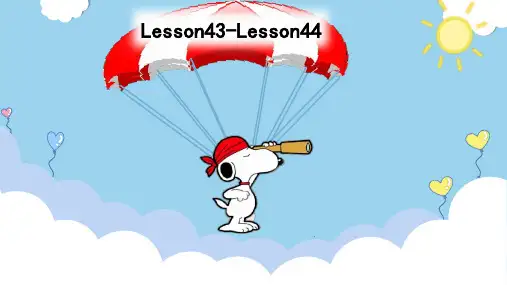
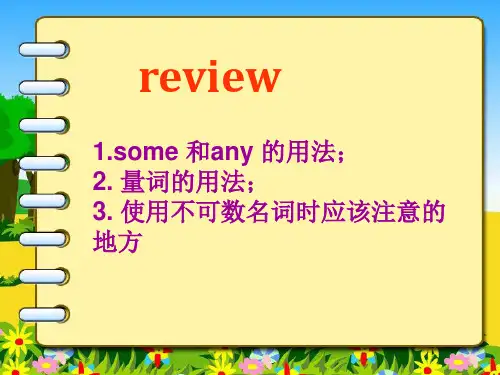
Lesson 43 Hurry up! 快点!排序:( ) Yes, of course I can, Penny. ( ) Yes. Here they are.( ) Where’s the tea? ( ) Can you see it?( ) Where are the cups?( ) Ah yes, I can see it now.( ) Can you find them? ( ) There are some in the cupboard.( ) Hurry up, Sam! The kettle’s boiling! ( ) I can see the teapot, but I can’t see the tea.( ) Can you make the tea? ( ) Is there any water in this kettle?( ) Yes, there is. ( ) There it is. It’s in front of you!( ) It’s over there, behind the teapot.一、Key words1.behind _________ ____ ___________;反义词;他坐在她后面。
;扫帚在门背后。
2.now _________ ____ ___________();他们正在做作业。
;他正在做饭吗?3.find_________ ____ ________();查出(真相);我找不到表了。
_____________________________;我们必须查出真相。
_____________________________________ 4.boil_________ ____ ____________ ;正在沸腾的;正在烧开的水我正在煮鸡蛋。
二、Key structuresCan you make the tea, Sam? Is there any water in this kettle?It’s over there, behind the teapot. I can see the teapot, but I can’t see the tea.三、TextCan you make the tea, Sam? 译文:__________________________________讲解:这是一个的句;can表示;can + do(动词原形);沏茶,生火如:你会游泳吗?Yes, of course I can, Penny. 译文:__________________________________讲解:,,都可以表示“当然”。
Lesson 43 Hurry up!【单词讲解】★of course 当然certainly['sɜːtnlɪ]当然(41课)sure 当然★behind 介词,表示空间方位关系在门后面在茶壶后面★kettle and teapotelectric kettleteapot★find sb/sth 找到了。
(强调结果) look for...sb/sth 寻找。
(强调动作)find out 找到,查明事情的真相、原由It is important tofind a hard-working person for the job. find an answer to the questionWe are looking for a pen.But it is not sure we can find it.你正在干嘛?我正在找钥匙我找到了我的汽车★boil v. (水)滚,(水)开,(水)沸腾boil ingThe kettle’s boi lingThe water in the kettle is boi ling【课文讲解】1.Can you make the tea, Sam ?Yes, of course I can, Penny.Can 情态动词,意思是:能。
会。
!make the teamake coffeemake the bedOf course = = 当然!2.Is there any water in this kettle ?(变肯定句)some用于肯定句,any用于否定句和一般疑问句3.where is the tea ? It’s over there, behind the teapot. tea 茶水,茶叶over therebehind the teapot4.There it is ! It’s in front of you !There it is !in front of5.Hurry up, Sam ! The kettle’s boil ing !Hurry up是句,意思是。